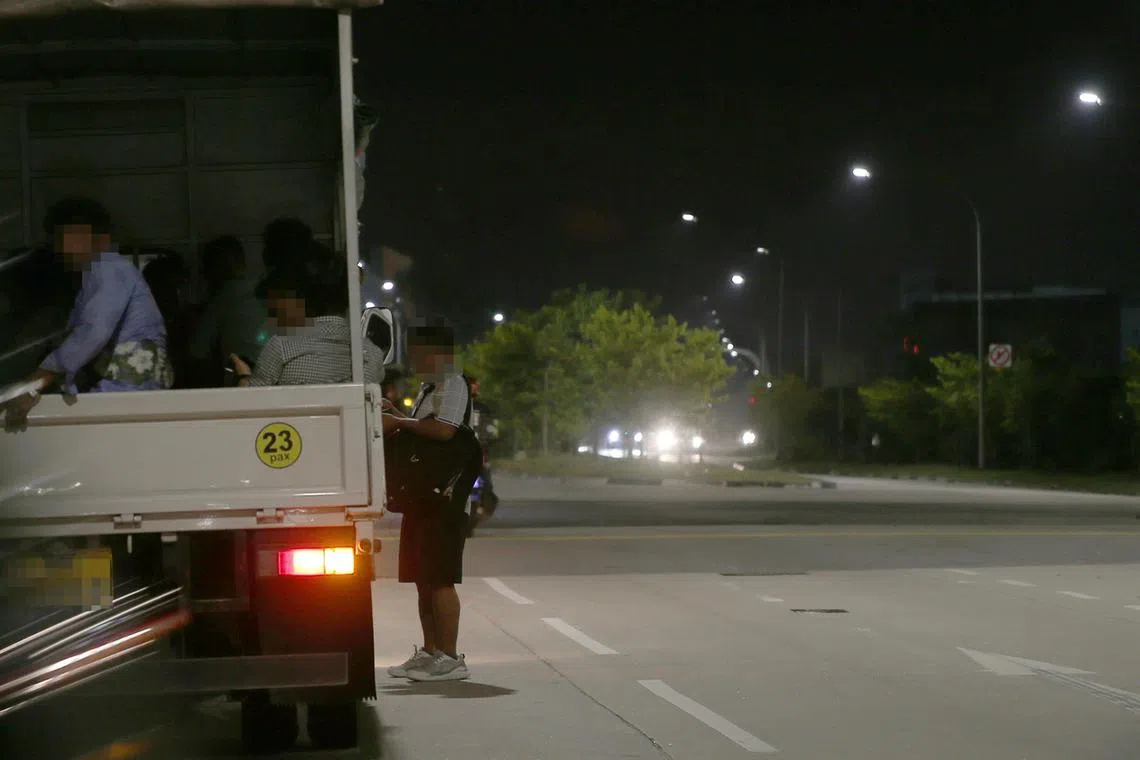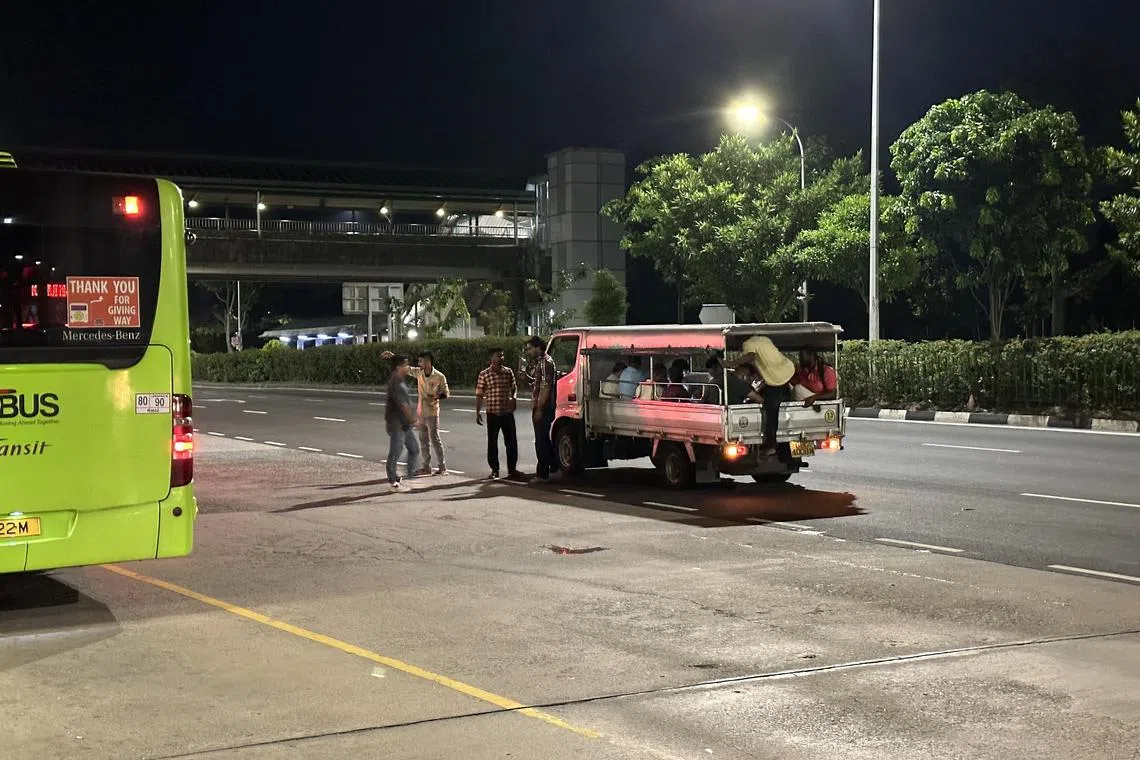Migrant workers rely on illegal lorry service in Kranji due to lack of transport options
Sign up now: Get ST's newsletters delivered to your inbox

On average, 10 trucks would wait in line just before the public bus bay outside Kranji MRT station for the throngs of people who rush for a seat to return to their dorms.
ST PHOTO: ZAIHAN MOHAMED YUSOF
Follow topic:
SINGAPORE – Migrant workers have been using an illegal transport service provided by lorry drivers to commute about 4km to their dormitories in Kranji Way from Kranji MRT station, due to a lack of bus services in the area.
Although SMRT bus services 925 and 925M ply the route, the former does not operate on Sundays and the latter ends its service at 7.40pm on Sundays and public holidays.
Workers returning from their day off on Sunday after 7.40pm say they have to rely on lorry drivers who charge them $2 for a one-way ride from Kranji MRT to their dormitories.
Accommodations for workers in the vicinity include the Westlite Kranji Way dormitory, which has 1,300 beds.
Migrant worker Gunasegran, who declined to give his full name, told The Straits Times that his employer does not provide transportation from the station to the dormitory, where he is a resident.
“What choice do I have? I’m already tired, and I don’t want to walk in the dark for 4.5km to get to my dorm,” he said.
Mr Sivakumar, who is also a resident of the dorm, said a taxi ride at night from the station can cost as much as $10.
The smaller lorries, which can ferry up to 12 people each, make multiple stops near workers’ accommodations in the Kranji area. Larger lorries that can seat up to 22 people have also been seen.
“I would rather take a bus on Sunday evenings, but at night there is no bus service,” said Mr Sivakumar.
The Land Transport Authority (LTA) said demand for service 925M is mainly from commuters visiting Sungei Buloh Wetland Reserve.
“When planning bus services, LTA balances serving as many commuters as possible with factors such as ridership and financial prudency,” said a spokesman, who added that the authority will continue to monitor commuter travel patterns and make appropriate adjustments to bus service provision where viable.
Checks by ST from mid-July to September showed that on average, 10 lorries would wait in line just before the public bus bay outside the station for the throngs of people who rush for seats to return to their dorms.
The lorry service, which starts only after 8pm on Sundays, continues till about 11pm.
When ST approached the drivers of five lorries spotted waiting near the Kranji MRT station bus bay, they denied that they were moonlighting and said they were waiting for their colleagues.
However, the drivers were later seen collecting money from passengers who were dropped off near the dorms. The same lorries then rejoined the queue at Kranji MRT station.
LTA said it is an offence to use a goods vehicle to transport workers who are not in the employment of the owner or hirer of the vehicle. A first-time offender can face a maximum fine of $1,000 or jail term of up to three months, or both.
Transport operator Singapore Maxicab said some employers engage transportation companies to ferry workers from places like Little India to dorms in Tuas, because purpose-built dorms are located in secluded areas.
These dorms can accommodate about 256,000 workers.

The drivers were seen collecting money from passengers who were dropped off near the dorms.
ST PHOTO: ZAIHAN MOHAMED YUSOF
Maxicab director Mohamed Ali said: “We offer a six-day transportation service, and we also offer pick-ups on workers’ days off. But there have been no takers for the latter.
“Most of the employers said, ‘Never mind, just pick them up only on work days.’”
Maxicab, which has been in the business for 12 years, charges between $2,000 and $2,200 a month for the service using a 13-seater minibus. It also operates seven-seater and nine-seater vans.
Mr Ali said workers’ transportation costs, including on their days off, should be included when tendering for projects.
Mr Bernard Tay, chairman of the Singapore Road Safety Council, said employers “cannot just leave migrant workers at the bus stop and hope for the best”, or let them “return on their own to the dormitories on the freelance lorries”.
“Employers must be responsible for their workers’ welfare not only on work days but also on their days off,” he added.

Migrant workers returning from visits to Little India on Sunday night will rush to board the lorries that will take them to their dorms in Kranji Way for $2.
ST PHOTO: ZAIHAN MOHAMED YUSOF
The Migrant Worker’s Centre (MWC) said it is concerned about the safety and welfare of the migrant workers, adding that the current arrangement of ferrying workers in the area is less than ideal.
“We understand the situation could have been exacerbated by the lack of alternative transportation options, and MWC hopes to work with the relevant stakeholders to review the situation,” a spokesman said.
Mr Aman Aljunied, a former Singapore Safety Driving Centre instructor, highlighted another issue – the lorries can pose a danger if they are parked illegally and cause congestion.
Several other bus services use the bus bay outside Kranji MRT station, including SBS Transit service 170X, which goes to Johor Bahru. Workers often walk between the buses to get to the lorries, which are parked on the first lane next to the bus bay.
“The danger is that there are many blind spots on moving buses,” said Mr Aman. It would be hard for drivers to see the migrant workers, he added.
LTA said all other vehicles are not allowed to park within 9m of a bus stop, in order to facilitate the boarding and alighting of commuters from public buses. Motorists doing so can be fined.
“We monitor our roads closely and will take action against those who park illegally,” said a spokesman, who added that closed-circuit television cameras are being used, along with stepped-up enforcement, to deter illegal parking in the area around Kranji MRT station.


